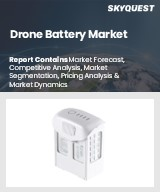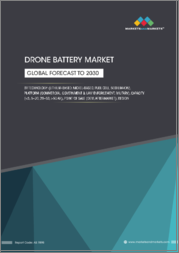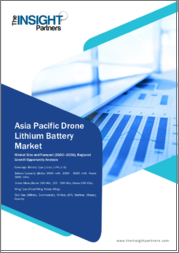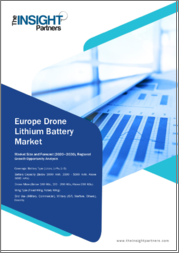
|
시장보고서
상품코드
1775279
세계의 UAV용 배터리 시장 평가 : UAV 클래스별, 배터리 화학별, 지역별, 기회, 예측(2018-2032년)Global UAV Battery Market Assessment, By UAV Class, By Battery Chemistry, By Region, Opportunities and Forecast, 2018-2032F |
||||||
세계의 UAV용 배터리 시장 규모는 2024년 61억 5,000만 달러에서 2032년에 119억 3,000만 달러에 달할 것으로 예측되며, 예측 기간인 2025-2032년에 CAGR로 8.64%의 성장이 전망됩니다. 이 시장은 전 세계 국방, 농업, 물류, 감시 부문 등에서 드론의 활용이 증가함에 따라 강력한 성장세를 보이고 있습니다. 리튬이온(Li-ion) 배터리와 리튬 폴리머(Li-Po) 배터리는 경량 특성과 최고의 에너지 밀도로 인해 현재 이 시장 공간을 지배하고 있습니다. 수소연료전지 또한 장시간 작전을 위한 낮은 유지보수성으로 인해 인기가 높아지고 있습니다. 중-고고도 장시간 비행(MALE) UAV는 장거리 작전에 대한 높은 수요로 인해 현재 시장을 주도하고 있습니다. 환경 독성 배터리의 법적 금지와 지속적인 발견으로 인해 일부 기업은 재활용 가능하고 지속가능한 배터리 기술을 개선하기 위해 기술 혁신을 하고 있습니다. 아시아태평양은 인도와 중국과 같은 개발도상국에서 UAV 사용이 빠르게 증가함에 따라 UAV의 최종사용자가 용도를 변경함에 따라 고성능, 고품질, 파괴적, 긴 수명의 배터리에 대한 수요가 시장에 지속적인 수요를 가져올 것으로 예측됩니다.
예를 들어 2025년 2월, Amprius Technologies, Inc.는 대형 무인항공기 시스템(UAS) 제조업체로부터 1,500만 달러 규모의 SiCore 리튬이온 배터리 주문을 확보했습니다. 이번 주문은 Amprius의 배터리를 해당 제조업체의 고정익 드론 플랫폼에 통합한 실사용 테스트가 성공적으로 완료된 데 따른 것입니다.
세계의 UAV용 배터리 시장에 대해 조사분석했으며, 시장 규모와 예측, 시장 역학, 주요 기업의 상황 등을 제공하고 있습니다.
목차
제1장 프로젝트 범위와 정의
제2장 조사 방법
제3장 미국 관세의 영향
제4장 개요
제5장 고객의 소리
- 응답자 인구통계
- 구입 결정에서 고려되는 요소
- 수명주기 비용 효율
- 전력 소비 효율
제6장 세계의 UAV용 배터리 시장 전망(2018-2032년)
- 시장 규모 분석과 예측
- 시장 점유율 분석과 예측
- UAV 클래스별
- 고고도 장시간 비행(HALE) UAV
- 중고도 장시간 비행(MALE) UAV
- 전술적 UAV
- 소형 UAV
- 기타
- 배터리 화학별
- 리튬이온
- 리튬 폴리머
- 연료전지
- 기타
- 지역별
- 북미
- 유럽
- 아시아태평양
- 남미
- 중동 및 아프리카
- 시장 점유율 분석 : 기업별(상위 5사와 기타)(금액)(2024년)
- UAV 클래스별
- 시장 맵 분석(2024년)
- UAV 클래스별
- 배터리 화학별
- 지역별
제7장 북미의 UAV용 배터리 시장 전망(2018-2032년)
- 시장 규모 분석과 예측
- 시장 점유율 분석과 예측
- UAV 클래스별
- 고고도 장시간 비행(HALE) UAV
- 중고도 장시간 비행(MALE) UAV
- 전술적 UAV
- 소형 UAV
- 기타
- 배터리 화학별
- 리튬이온
- 리튬 폴리머
- 연료전지
- 기타
- 점유율 : 국가별
- 미국
- 캐나다
- 멕시코
- UAV 클래스별
- 각국의 시장 평가
- 미국의 UAV용 배터리 시장 전망(2018-2032년)
- 시장 규모 분석과 예측
- 시장 점유율 분석과 예측
- 캐나다
- 멕시코
- 미국의 UAV용 배터리 시장 전망(2018-2032년)
제8장 유럽의 UAV용 배터리 시장 전망(2018-2032년)
- 독일
- 프랑스
- 이탈리아
- 영국
- 러시아
- 네덜란드
- 스페인
- 튀르키예
- 폴란드
제9장 아시아태평양의 UAV용 배터리 시장 전망(2018-2032년)
- 인도
- 중국
- 일본
- 호주
- 베트남
- 한국
- 인도네시아
- 필리핀
제10장 남미의 UAV용 배터리 시장 전망(2018-2032년)
- 브라질
- 아르헨티나
제11장 중동 및 아프리카의 UAV용 배터리 시장 전망(2018-2032년)
- 사우디아라비아
- 아랍에미리트
- 남아프리카공화국
제12장 밸류체인 분석
제13장 Porter's Five Forces 분석
제14장 PESTLE 분석
제15장 가격 분석
제16장 시장 역학
- 시장 성장 촉진요인
- 시장이 해결해야 할 과제
제17장 시장 동향과 발전
제18장 사례 연구
제19장 경쟁 구도
- 시장 리더 상위 5사의 경쟁 매트릭스
- 상위 5사의 SWOT 분석
- 상위 10사의 주요 기업 상황
- Hylium Industries Inc.
- Ballard Power Systems Inc.
- InoBat j.s.a.
- Denchi Power Limited
- Sion Power Corporation
- Tadiran Batteries
- Shenzhen Grepow Battery Co., Ltd.
- H3 Dynamics Holdings Pte. Ltd.
- Epsilor-Electric Fuel Ltd.
- EaglePicher Technologies LLC
제20장 전략적 제안
제21장 조사회사 소개·면책사항
KSA 25.07.31Global UAV Battery market is projected to witness a CAGR of 8.64% during the forecast period 2025-2032, growing from USD 6.15 billion in 2024 to USD 11.93 billion in 2032. The UAV battery market is being driven by strong growth, due to increasing drone usage across the global defense, agricultural, logistics, and surveillance sectors, etc. Lithium-ion (Li-ion) and lithium-polymer (Li-Po) batteries currently dominate this market space, due to their beneficial lightweight properties with the highest energy density. Hydrogen fuel cells are also increasing in popularity, due to the low maintenance for long-duration missions. Medium-altitude long endurance (MALE) UAVs are currently market-leading due to the high demand for long-range missions. The continual discovery and legal banning of environmentally toxic batteries is also forcing some companies to innovate to improve recyclable and sustainable battery technologies. Asia-Pacific will be emerging, due to the rapidly increasing use of UAVs in developing nations like India and China. As end-users of UAV's modify their applications, the demand for high-performance, high-quality, disruptive, and long-lasting batteries will bring continuous demand in the market.
For instance, in February 2025, Amprius Technologies, Inc. secured a USD 15 million purchase order for its SiCore lithium-ion cells from a leading unmanned aircraft system (UAS) manufacturer. The order follows successful field trials in which Amprius batteries were integrated into the manufacturer's fixed-wing drone platform.
Rising Commercial Demand Fuels Expansion of UAV Battery Market
The UAV battery industry is growing quickly with commercial uses for drones expanding within agriculture, delivery and logistics, infrastructure inspections, and cinematography. These commercial applications utilize lightweight, high-capacity batteries to achieve longer flight times for the drone with more payload capacity. The UAV battery market is largely dependent upon lithium-ion or lithium-polymer technology, which provides energy density and rapid recharge time. The use of drones is becoming part of civil operations, and manufacturers are developing sustainable chemistries, AI-driven optimization, etc. There is a long-term shift from military-dominant use of drones to widespread commercial adoption of drones, which will change the UAV battery market and drive technology development and growth in the Global Market.
For instance, in June 2025, Factorial Inc. and Avidrone Aerospace Inc. partnered to deploy FEST solid-state lithium-metal batteries in high-endurance unmanned aerial systems (UAS). This marked Factorial's first aerial deployment of its proprietary battery technology, with integration into Avidrone's cargo drone platform for extended-range missions.
Smart Power Monitoring Boosts UAV Battery Innovation and Market Momentum
Smart power monitoring systems are reshaping the UAV battery world and ultimately fueling an innovation cycle and market share growth. These systems optimize energy consumption, battery efficiency, and diagnostics, resulting in longer flight duration and improved reliability. Advanced data analytics improve upon classic predictive maintenance, which not only reduces systematic downtime costs but also operational costs. Requirements for longer-endurance drones are increasing in various markets, especially for logistics, agriculture, and surveillance. Smart power solutions will help differentiate these products and create additional markets of growth. This innovation has also spurred research and development into batteries that are both high-capacity and fast-charging and attracted investment into UAV infrastructure. Finally, as data collection capabilities expand, the integration of AI and IoT fortifies smart power monitoring to the overall momentum driving the UAV market and the eventual realization of next-generation drone applications.
For instance, in November 2024, Li-S Energy Ltd. powered a fixed-wing UAV using its 12-cell lithium-sulfur battery pack, achieving a 30-minute flight with no recharge. The semi-solid-state cells delivered 456Wh/kg energy density, validating their integration into aerial platforms.
Expansion of UAV Battery Market Driven by Rising Adoption of Small Drones
The increasing adoption of small UAVs in commercial, defense, and hobbyist segments represents a significant growth opportunity for the UAV battery market. Small, lightweight drones require small form factor, high-power batteries that enable longer flight times and faster recharge times. Lithium-ion and new solid-state technologies are leading the growth of energy-dense and rugged batteries. Small UAVs are increasingly being used for jobs such as surveillance, mapping, package delivery, and agronomical monitoring. The different forms of UAVs being deployed raise the demand for a dependable power supply. As miniaturization and automation trends continue, manufacturers are interested in designing smart battery systems with new safe chemistries to respond to the evolving operational requirements of small UAVs. The use of small UAVs represents an eco- and techno-approach to restarting a new cycle of battery innovation and market growth.
For instance, in February 2025, Tata Elxsi Ltd. and Garuda Aerospace Pvt. Ltd. signed an MoU at Aero India 2025 to establish a Centre of Excellence for indigenous UAV design and certification. The initiative supports Make in India, targeting defense, agriculture, and smart city applications with AI-powered drone technologies.
Asia-Pacific Dominates the UAV Battery Market
The UAV battery market in Asia-Pacific is expanding due to factors such as increased drone usage across several industries, including agriculture, logistics, surveillance, and infrastructure. Continued advances in battery technology, both concerning lithium-ion, solid-state, and lithium-sulfur batteries (for improved energy density, flight times, and safety), are taking place. Clean technology is driving innovation through recyclable battery materials and environment-friendly designs. Smart battery management systems improve battery reliability and operational efficiency through real-time monitoring and updates. Urbanization and smart cities are enabling the increase in drone usage for city monitoring, while defence modernization programs are employing UAVs for tactical missions. Voluntary regulations introduced by governments, as well as the cooperation between UAV manufacturers and battery industry developers to collaborate, are all contributing to the growth of technology and innovation in the Asia-Pacific, leading towards more UAV power solution opportunities.
For instance, in March 2025, Li-S Energy Limited (ASX: LIS) and Kea Aerospace Limited signed a collaboration agreement to integrate lithium-sulfur battery technology into Kea's high-altitude UAVs. The partnership aims to enhance the endurance of Kea's solar-powered ATMOS aircraft, which operate between 55,000 and 65,000 feet.
Impact of U.S. Tariffs on Global UAV Battery Market
U.S. tariffs on imported UAV batteries, specifically from China, created immense stress on the supply chains. Manufacturers are encountering rising costs and logistical issues, motivating them to look for new sources, including domestically, and partnerships in India or Vietnam.
While some manufacturers are accelerating their efforts to localize the production processes in North America, the pursuit of an entirely self-sufficient battery ecosystem will take a long time to accomplish.
The tariffs have inspired designs and ingenuity in new materials; however, they have generated uncertainty in the supply chains that ultimately impact the development of UAVs in both commercial and defense.
Key Players Landscape and Outlook
The UAV battery sector is moving at a fast pace, with demand increasing for flight time, quicker charging and better safety. Changes in energy density, heat removal, and weight reduction are altering the design priorities across defense, commercial and agriculture markets. With drone operations getting more complex, manufacturers are also concentrating on durability, modular design and new propulsion system compatibility. The outlook seems to suggest sustainable chemistries, smarter battery management systems, regional production and partnerships will be essential to meet future anticipated performance and reliability requirements.
For instance, in May 2025, Slovak startup InoBat j.s.a. launched its new E10 battery, tailored for military drones and unmanned aerial systems. The battery offers faster charging, longer endurance, and complies with NATO supply chain standards. Production is expected to begin in September 2025, supporting European defense capabilities through strategic collaborations.
Table of Contents
1. Project Scope and Definitions
2. Research Methodology
3. Impact of U.S. Tariffs
4. Executive Summary
5. Voice of Customers
- 5.1. Respondent Demographics
- 5.2. Factors Considered in Purchase Decisions
- 5.2.1. Lifecycle Cost Efficiency
- 5.2.2. Power Consumption Efficiency
6. Global UAV Battery Market Outlook, 2018-2032F
- 6.1. Market Size Analysis & Forecast
- 6.1.1. By Value
- 6.2. Market Share Analysis & Forecast
- 6.2.1. By UAV Class
- 6.2.1.1. High-Altitude Long-Endurance (HALE) UAVs
- 6.2.1.2. Medium-Altitude Long-Endurance (MALE) UAVs
- 6.2.1.3. Tactical UAVs
- 6.2.1.4. Small UAVs
- 6.2.1.5. Others
- 6.2.2. By Battery Chemistry
- 6.2.2.1. Lithium-Ion
- 6.2.2.2. Lithium-Polymer
- 6.2.2.3. Fuel Cell
- 6.2.2.4. Others
- 6.2.3. By Region
- 6.2.3.1. North America
- 6.2.3.2. Europe
- 6.2.3.3. Asia-Pacific
- 6.2.3.4. South America
- 6.2.3.5. Middle East and Africa
- 6.2.4. By Company Market Share Analysis (Top 5 Companies and Others - By Value, 2024)
- 6.2.1. By UAV Class
- 6.3. Market Map Analysis, 2024
- 6.3.1. By UAV Class
- 6.3.2. By Battery Chemistry
- 6.3.3. By Region
7. North America UAV Battery Market Outlook, 2018-2032F
- 7.1. Market Size Analysis & Forecast
- 7.1.1. By Value
- 7.2. Market Share Analysis & Forecast
- 7.2.1. By UAV Class
- 7.2.1.1. High-Altitude Long-Endurance (HALE) UAVs
- 7.2.1.2. Medium-Altitude Long-Endurance (MALE) UAVs
- 7.2.1.3. Tactical UAVs
- 7.2.1.4. Small UAVs
- 7.2.1.5. Others
- 7.2.2. By Battery Chemistry
- 7.2.2.1. Lithium-Ion
- 7.2.2.2. Lithium-Polymer
- 7.2.2.3. Fuel Cell
- 7.2.2.4. Others
- 7.2.3. By Country Share
- 7.2.3.1. United States
- 7.2.3.2. Canada
- 7.2.3.3. Mexico
- 7.2.1. By UAV Class
- 7.3. Country Market Assessment
- 7.3.1. United States UAV Battery Market Outlook, 2018-2032F*
- 7.3.1.1. Market Size Analysis & Forecast
- 7.3.1.1.1. By Value
- 7.3.1.2. Market Share Analysis & Forecast
- 7.3.1.2.1. By UAV Class
- 7.3.1.2.1.1. High-Altitude Long-Endurance (HALE) UAVs
- 7.3.1.2.1.2. Medium-Altitude Long-Endurance (MALE) UAVs
- 7.3.1.2.1.3. Tactical UAVs
- 7.3.1.2.1.4. Small UAVs
- 7.3.1.2.1.5. Others
- 7.3.1.2.2. By Battery Chemistry
- 7.3.1.2.2.1. Lithium-Ion
- 7.3.1.2.2.2. Lithium-Polymer
- 7.3.1.2.2.3. Fuel Cell
- 7.3.1.2.2.4. Others
- 7.3.1.2.1. By UAV Class
- 7.3.1.1. Market Size Analysis & Forecast
- 7.3.2. Canada
- 7.3.3. Mexico
- 7.3.1. United States UAV Battery Market Outlook, 2018-2032F*
All segments will be provided for all regions and countries covered
8. Europe UAV Battery Market Outlook, 2018-2032F
- 8.1. Germany
- 8.2. France
- 8.3. Italy
- 8.4. United Kingdom
- 8.5. Russia
- 8.6. Netherlands
- 8.7. Spain
- 8.8. Turkey
- 8.9. Poland
9. Asia-Pacific UAV Battery Market Outlook, 2018-2032F
- 9.1. India
- 9.2. China
- 9.3. Japan
- 9.4. Australia
- 9.5. Vietnam
- 9.6. South Korea
- 9.7. Indonesia
- 9.8. Philippines
10. South America UAV Battery Market Outlook, 2018-2032F
- 10.1. Brazil
- 10.2. Argentina
11. Middle East and Africa UAV Battery Market Outlook, 2018-2032F
- 11.1. Saudi Arabia
- 11.2. UAE
- 11.3. South Africa
12. Value Chain Analysis
13. Porter's Five Forces Analysis
14. PESTLE Analysis
15. Pricing Analysis
16. Market Dynamics
- 16.1. Market Drivers
- 16.2. Market Challenges
17. Market Trends and Developments
18. Case Studies
19. Competitive Landscape
- 19.1. Competition Matrix of Top 5 Market Leaders
- 19.2. SWOT Analysis for Top 5 Players
- 19.3. Key Players Landscape for Top 10 Market Players
- 19.3.1. Hylium Industries Inc.
- 19.3.1.1. Company Details
- 19.3.1.2. Key Management Personnel
- 19.3.1.3. Key Products Offered
- 19.3.1.4. Key Financials (As Reported)
- 19.3.1.5. Key Market Focus and Geographical Presence
- 19.3.1.6. Recent Developments/Collaborations/Partnerships/Mergers and Acquisitions
- 19.3.2. Ballard Power Systems Inc.
- 19.3.3. InoBat j.s.a.
- 19.3.4. Denchi Power Limited
- 19.3.5. Sion Power Corporation
- 19.3.6. Tadiran Batteries
- 19.3.7. Shenzhen Grepow Battery Co., Ltd.
- 19.3.8. H3 Dynamics Holdings Pte. Ltd.
- 19.3.9. Epsilor-Electric Fuel Ltd.
- 19.3.10. EaglePicher Technologies LLC
- 19.3.1. Hylium Industries Inc.
Companies mentioned above DO NOT hold any order as per market share and can be changed as per information available during research work.



















